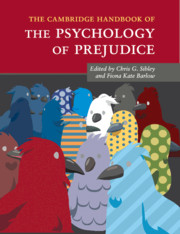Book contents
- Frontmatter
- Dedication
- Contents
- List of Figures
- List of Tables
- Notes on the Contributors
- Part I General Theoretical Perspectives
- Part II Prejudice in Specific Domains
- Part III Prejudice Reduction and Analysis in Applied Contexts
- 20 Recent Developments in Intergroup Contact Research: Affective Processes, Group Status, and Contact Valence
- 21 From Prejudice Reduction to Collective Action: Two Psychological Models of Social Change (and How to Reconcile Them)
- 22 Self-Regulation Strategies for Combatting Prejudice
- 23 Antecedents and Consequences of Evaluative Concerns Experienced During Intergroup Interaction: When and How Does Group Status Matter?
- 24 Stereotypicality Biases and the Criminal Justice System
- 25 Prejudice, Stigma, Bias, Discrimination, and Health
- 26 Development of Delegitimization and Animosity in the Context of Intractable Conflict
- 27 Interventions in Real-World Settings: Using Media to Overcome Prejudice and Promote Intergroup Reconciliation in Central Africa
- 28 Identification with All Humanity: The Antithesis of Prejudice, and More
- 29 It's All About Ignorance: Reflections from the Blue-eyed/Brown-eyed Exercise
- Index
- References
27 - Interventions in Real-World Settings: Using Media to Overcome Prejudice and Promote Intergroup Reconciliation in Central Africa
from Part III - Prejudice Reduction and Analysis in Applied Contexts
Published online by Cambridge University Press: 17 November 2016
- Frontmatter
- Dedication
- Contents
- List of Figures
- List of Tables
- Notes on the Contributors
- Part I General Theoretical Perspectives
- Part II Prejudice in Specific Domains
- Part III Prejudice Reduction and Analysis in Applied Contexts
- 20 Recent Developments in Intergroup Contact Research: Affective Processes, Group Status, and Contact Valence
- 21 From Prejudice Reduction to Collective Action: Two Psychological Models of Social Change (and How to Reconcile Them)
- 22 Self-Regulation Strategies for Combatting Prejudice
- 23 Antecedents and Consequences of Evaluative Concerns Experienced During Intergroup Interaction: When and How Does Group Status Matter?
- 24 Stereotypicality Biases and the Criminal Justice System
- 25 Prejudice, Stigma, Bias, Discrimination, and Health
- 26 Development of Delegitimization and Animosity in the Context of Intractable Conflict
- 27 Interventions in Real-World Settings: Using Media to Overcome Prejudice and Promote Intergroup Reconciliation in Central Africa
- 28 Identification with All Humanity: The Antithesis of Prejudice, and More
- 29 It's All About Ignorance: Reflections from the Blue-eyed/Brown-eyed Exercise
- Index
- References
Summary
Prejudice is one of the most studied topics in social psychology, and much of this work has an explicit applied focus on prejudice reduction. Yet, we have a long road ahead in designing and rigorously assessing the effectiveness of evidence-based prejudice reduction interventions in real-world settings. In a review of prejudice reduction literature, Paluck and Green (2009) showed that less than half the studies in this area assessed the causal impact of prejudice reduction interventions, and of these, most were conducted in laboratory settings. Of the field experimental studies (11% of all studies reviewed), the vast majority were conducted in schools. Moreover, the research in this area relies heavily on student populations in Western countries (Henry, 2008). Consequently, we know little about prejudice reduction in conflict-affected countries, and in contexts of ongoing violence or its aftermath.
In the past decade, however, important theoretical and empirical developments in social psychology have started to address the nature of intergroup relations in conflict-affected countries, broadening the scope of interventions from prejudice reduction to more generally improving intergroup relations and promoting reconciliation. Premises of influential social psychological theories, such as social identity theory (see Chapter 3) or contact hypothesis (see Chapter 6), have been tested and extended to a number of ongoing and post-conflict settings including Bosnia, Cyprus, Israel, Lebanon, Northern Ireland, Rwanda, and so on (e.g., Čehajić, Brown, & Castano, 2008; Kanazayire, Licata, Melotte, Dusingizemungu, & Azzi, 2014). In addition, new concepts and approaches have been developed to capture psychological and social processes unique to contexts of violent conflict (e.g., Chapter 26 in this title; Bar-Tal, 2007; Kelman, 1990; Staub, 1989, 2011). Exciting and productive research programs have emerged on intergroup reconciliation (e.g., Shnabel & Nadler, 2008; Staub, 2011), victimhood (e.g., Noor, Brown, Gonzalez, Manzi, & Lewis, 2012; Vollhardt, 2012; Vollhardt & Bilali, 2015), intergroup forgiveness (e.g., Tam et al., 2007), and intergroup apologies (e.g., Blatz, Schumann, & Ross, 2009). These new developments have practical implications, as the principles and findings can guide interventions to promote reconciliation and reduce prejudice in conflict settings (e.g., Hameiri, Bar-Tal, & Halperin, 2014).
In this chapter, we aim to contribute to this growing literature in two important ways. First, despite the important strides made, our knowledge of psychological interventions in conflict and post-conflict settings is limited and at an early stage of development.
- Type
- Chapter
- Information
- The Cambridge Handbook of the Psychology of Prejudice , pp. 607 - 631Publisher: Cambridge University PressPrint publication year: 2016
References
- 5
- Cited by



